

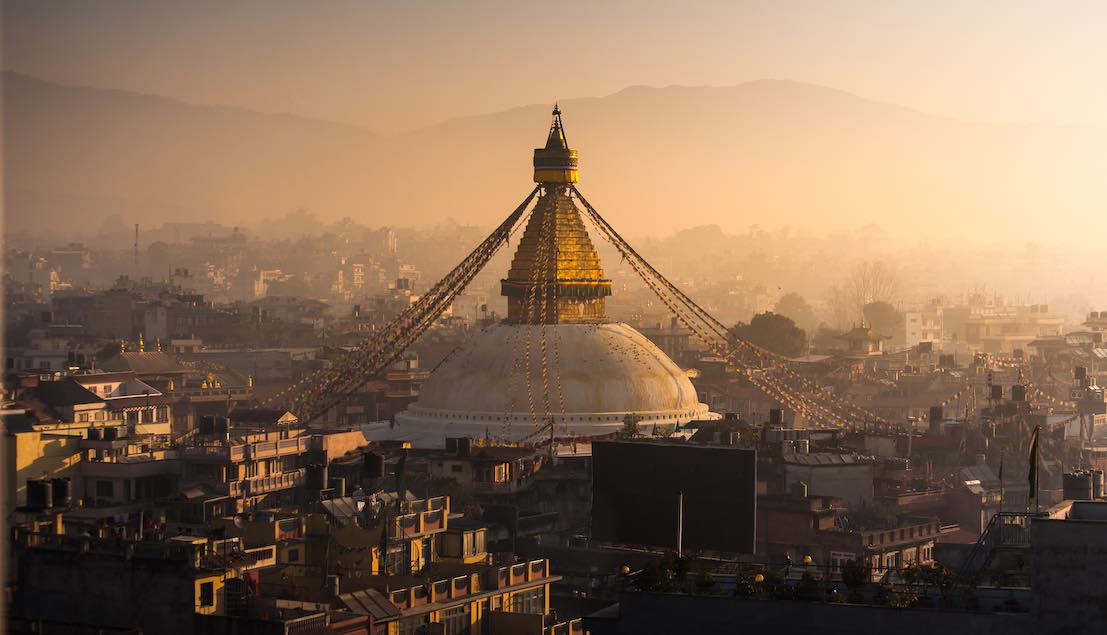
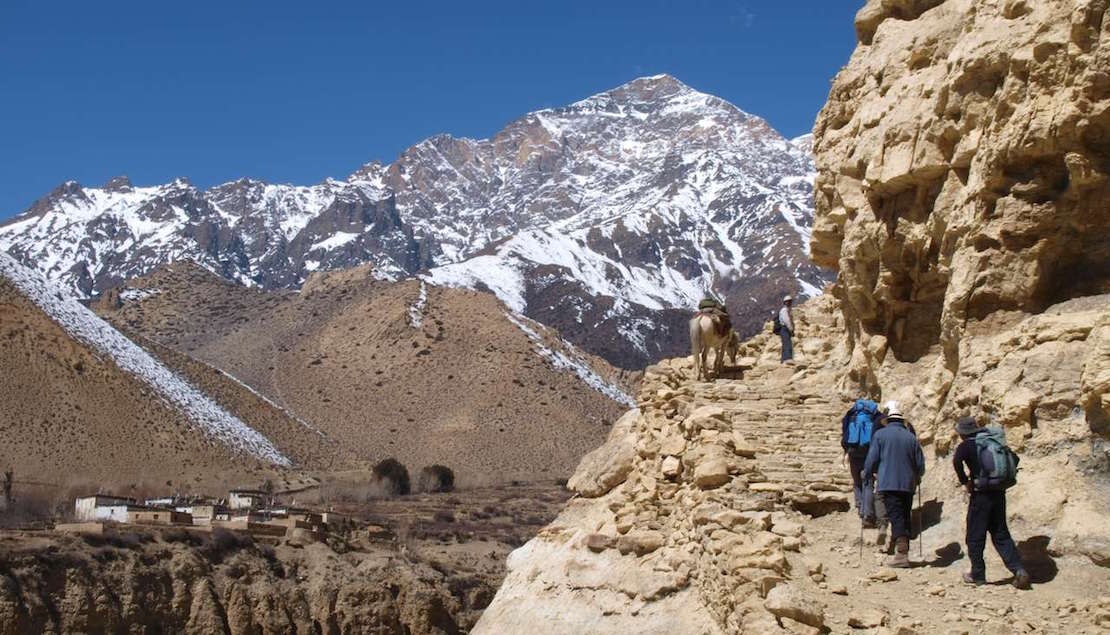
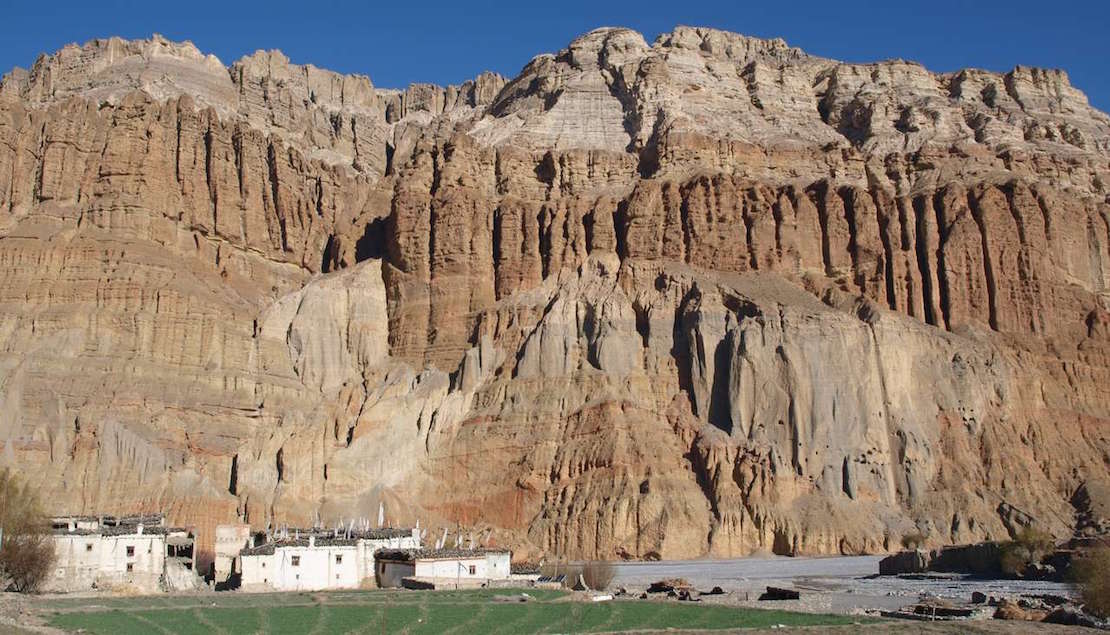
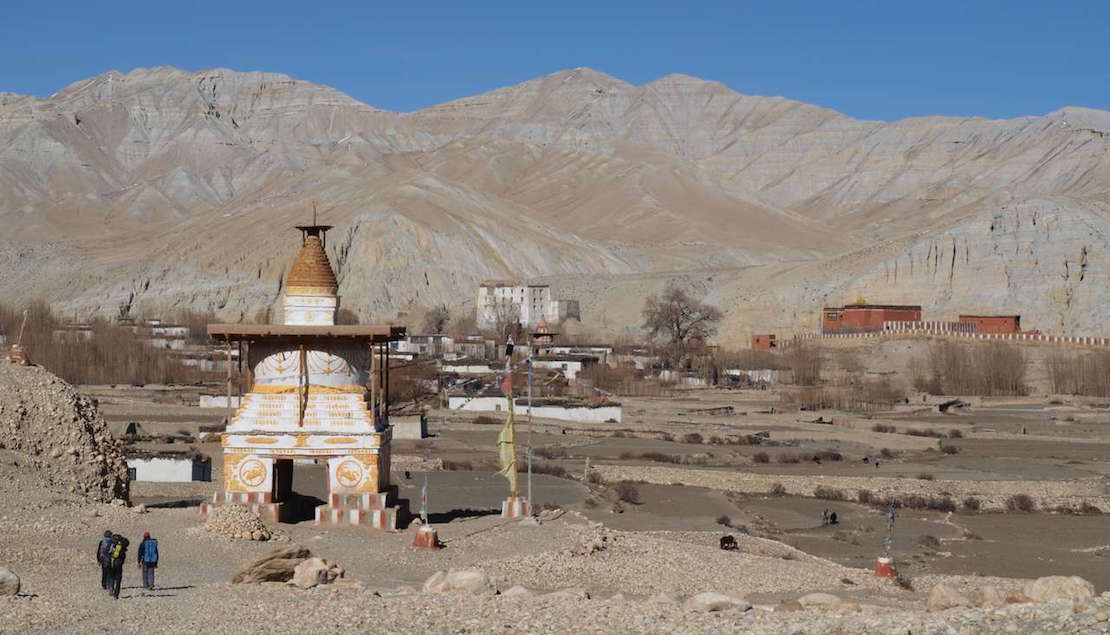
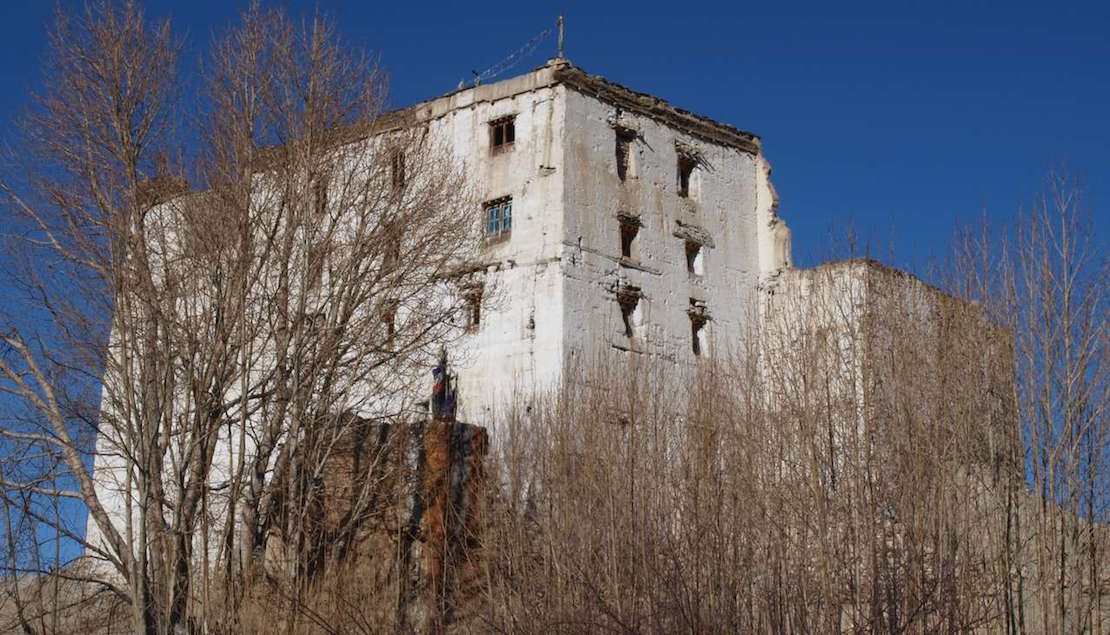
Discover one of the last bastions of undisturbed, living Tibetan culture by jeep and foot in the shadow of the Himalayas.
- Expert-led trek to Mustang, the most spectacular walk through the Himalaya
- Spend time exploring the fabled city of Lo Manthang
- Spectacular aerial views of the Himalayan ranges
- The last bastion of Tibetan Buddhism
The Kingdom of Mustang is perched on the border with Tibet and for many years was closed to foreign visitors. However, the Nepalese government re-opened the region in 1992 - for limited numbers of organised trekking groups. Mustang is a barren landscape with only a few small green fields dotting a lunar landscape, but boasts a remarkable spiritual heritage. The region is one of the last bastions of undisturbed, living Tibetan culture.
This group tour combines travelling by jeep and on foot through Mustang’s fascinating villages, alongside Buddhist shrines and temples, in the shadow of the iconic Himalayas.
WHY SHOULD I JOIN THIS GROUP TOUR TO NEPAL'S MUSTANG VALLEY?
This tour gives lovers of wilderness, an opportunity to visit a wild and remote area; to go beyond the normal tours in the Himalaya and to walk in the footsteps of ancient caravan routes. Please note this is not a trekking trip, but a tour designed to appeal to people whom love being in the mountains but do not want to spend every hour of every day, trekking. The group will travel by jeep but there will be stops en route to give you the opportunity to walk and explore. You can walk as much or as little, as you like.
WHY TRAVEL WITH NIMA LAMA?
A key factor contributing to the success of our Upper Mustang walking and jeep safari is the skill, courtesy and experience of our tour expert, Nima Lama. Nima and his crew members know this area better than most and give close attention to every detail of the trip, to ensure a safe, comfortable, fun and fulfilling adventure.
Nima Lama’s passion for the Himalaya goes beyond trekking and he is an active first aid responder - qualifying from the National Outdoor Leadership School (NOLS) from Wyoming, USA. His charity work has involved him in the Nepal earthquake response in April/May 2015.
ITINERARY
Kathmandu is the capital city of Nepal - a heady and extravagant tangle of contrasts. Rapidly developing and almost alarmingly hectic, Kathmandu is a city to awake the senses, but it is not without its spiritual and cultural side. The old quarter's back streets, while still teeming with life and an array of smells from spices to incense, offer a more colourful side to the city.
Arrival in Kathmandu
Upon arrival in Kathmandu, you will be transferred to the Shangri La Hotel. The drive from the airport to the hotel is around 20 minutes.
A briefing will be given by Nima and is scheduled for the late afternoon. He will discuss the trekking program and co-ordinate any last minute arrangements and hand over your trek pack.
In the evening, Nima will organise a welcome meal at one of Kathmandu's fine Nepali restaurants.
You will be staying at Shangri La Hotel - Kathmandu, As specified
Kathmandu to Pokhara
After a leisurely morning, you will be transferred with Nima and the group from the hotel to the domestic terminal of Kathmandu's Tribhuvan Airport for the flight to Pokhara. The short flight offers spectacular views of the main Himalayan chain including the 8000-metre peaks of Manaslu (8163metres) and Annapurna (8091metres).
After arriving in Pokhara, you are then transferred to the Shangri La Resort, where you will have time to explore the lakeside area of the town.
In the evening, there is the option to dine out at one of the many fine lakeside restaurants.
Fly Pokhara to Jomson and, travel onto Chhusang
Weather permitting, the flight from Pokhara to Jomsom (2720metres) leaves early in the morning and is perhaps the most exciting flight in Nepal. There are fantastic views as you fly up the Kali Ghandaki Gorge, flanked on either side by the Himalayan giants of Annapurna 1 (8091metres) and Dhaulagiri (8167metres). The crew will already be in Jomsom (2715metres), awaiting your arrival.
You then begin the trip from the airport on the west bank of the Kali Ghandaki River before quickly crossing to the east bank and into the main part of Jomsom. From here, hire a jeep and follow the pilgrim road to Eklebhatti, where the main road ascends to Muktinath (3880metres). You will then bear left and continue up the Kali Ghandaki valley to the small village of Kagbeni, which, marks the beginning of the restricted zone. Here with the help of Nima and the local team, you will complete permit formalities and then continue on the road on a series of short ascents and descents on the east bank of the Kali Ghandaki. The next village from Kagbeni is Tangbe (2940metres), located above the valley and identified by a trio of black, red and white chortens (Buddhist shrines). Drive past Tangbe with the road gradually climbing up to a pass and then descending towards the Kali Gandaki to reach the village of Chhusang.
Chussang is a small village on the banks of the Kali River surrounded by huge red and orange sculptured cliffs with inaccessible caves.
A relatively small city and known as one of the main gateways to the Himalayas, Pokhara is one of the most popular destinations in Nepal. Visitors are greeted by the stunning Mt Machhapuchhre, which looms large and reflects in the still waters of Lake Taal. Activities in Pokhara would include hiring a boat on the lake (Phewa Tal), which is the second largest in Nepal. Pokhara has an interesting old area as well as an elaborate Hindu temple and a Buddhist monastery. The lakeside area has good shopping opportunities and internet cafés. In the evening there is the option to dine out at one of the many fine lakeside restaurants .
Chhusang to Ghami
The drive from Chussang to Chaile takes about 30 minutes as you will follow the Kali Gandaki upstream and cross just below Chaile (3100metres). From here the road winds along the ridges below Taklam La (3624metres) and Dajong La (3660metres) which will offer spectacular views, to reach the small settlement of Samar (3620metres). There will be a stop here for tea and the chance to stretch your legs and walk through the gateway above Samar to descend to a small stream. The trail traverses through open fields and then you cross the Jhuwa Khola to ascend to a small pass at Bhena La (3830metres) where your jeep awaits us. The views from the pass are spectacular on a clear day as you can see Nilgiri North (7061metres) and Tilicho (7130metres) towards the south along with Purkhung Himal.
After exalting in the views from Bhena La you will get on the jeep and drive, bypassing a lone teahouse to another pass of Bega La (3840metres). From here the road descends and then climbs up to Yamda La (4010metres) to reach the village of Syangmochen (3800metres) where you will have another stop, this time for lunch.
After lunch, the road climbs up to Syangmochen La (3850metres) and then gently climbs up and traverses through the small settlements of Tamagaon and Chhunggar to reach a lone teahouse at Jhaite (3820metres).
From Jhaite the road winds up to the pass at Nyi La (4020metres). From the top of the pass you can see Nilgiri, Tilicho, Annapurna (8091metres) along with Yakwakang (6482metres) towards the south. From Nyi La the road descends and winds below the ridge of Ghami La (3765metres) to reach the sprawling village of Ghami. Arrive at Ghami in the late afternoon, and after settling in you can go for an exploration of the village and perhaps visit the 500 year old monastery founded by Norchen Kunga the patron saint of the Kingdom of Lo.
In Ghami, you can see the ruins of the Old Palace built by Ame Pal the first King of Lo in the 14th century.
Todays drive, should take around five hours, with additional time allowed for stops along the way.
Ghami to Tsarang
After breakfast, drive down to the Ghami Khola and then climb up to the longest Mani Wall in Mustang. The Mani wall rolls out to the valley and the road starts to climb up Chinggel La (3870metres) and then gradually descends to the Tsarang Valley. You are welcomed with a big Chorten Gate and the big ochre coloured Tsarang Monastery looming behind the village.
Tsarang is one of the larger villages in Mustang having more than 80 houses and is situated just above the Tsarang Khola canyon. It used to be one of the capitals of the Kingdom of Lo in the 14th century. Stonewalls separate the houses and there is a labyrinth of irrigation canals along the streets. Being one of the prominent villages Tsarang has many shops and the village boasts of its own Hydro Electric plant and a mineral water bottling plant. Just adjacent to the monastery lies the five-storied Tsarang Dzong, which is somewhat in ruins now but still worth a visit for its collection of armory (Fortified Palace) and the living quarters and the prayer room of the King of Lo. The Tsarang Gompa, which follows the Sakya tradition, was built in 1385 built by Ame Pal the first king of Lo along with the palace fort. Tsarang Gompa is adorned with fantastic 15th century frescos in the assembly hall walls.
Todays drive, should take around two hours, with additional time allowed for stops along the way.
Tsarang to Lo Manthang
From Tsarang the road skirts to the end of the village and descends to the Tsarang river and then climbs up to a small pass. From here, the road traverses and undulates to a big stupa of Sungda Chorten where it climbs up. The views of the rolling barren hills and ocre cliffs is amazing and then the road traverses to Lo La (3950metres) which offers great views of the fabled city of Lo Manthang. From here the road descends to Dogpolo Khola and climbs to Lo Manthang.
You will now reach the mystical capital of Lo. The walls of the city house about 180 dwellings, most inhabited by the noble men and other high-ranking office bearers of the Kings court. Ame Pal the first King of Mustang built the walled city in 1385 and the area where it stands today is on what was called the "The Plain of Aspiration". The city is quite prosperous primarily due to its past salt and wool trade along the Kali Gandaki with Tibet.
Lo Manthang traditionally had a single entrance, through which only the King, Queen and Khempo (Abbot) were allowed to ride through. All the other inhabitants had to walk through the gates. Next to the entrance is the four-storied palace of the King within the city walls. The last king was the 25th descendent of Ame Pal.
There are four major monasteries within the walls of Lo Manthang, the 14th century, Jamba Lhakhang (the oldest gompa, built in 1387, with the striking 50 foot 'Jamba or Maitreya' (Future Buddha), the Thubchen Gompa (built in the 15th century) having 30 feet high pillars in the Great Assembly hall and beautiful murals on the walls which are being restored at the moment, Chhoede Gompa and Choprang Gompa.
Monastery visiting hours are usually between 11am and at 3pm. There are approximately 1300 people (The people of Lo Manthang are called Lobas) within the walled city and many of the lower caste Lobas live outside the main city.
Todays drive, should take around two hours.
Lo Manthang
Leaving Lo Manthang you drive down to cross the Dokpa Khola and then climb up along a wide canyon trail past the ruins of an ancient fortress. You then, drive along the plains on the western banks of the Mustang River passing a few Chortens and past the High School to reach the small settlement of Chhosar. You will have short stop at the tributary of the Mustang River, where you will then walk following the river upstream for about 30 minutes to reach the medieval man made caves of Jhong believed to be more than 2500 years old. You will then climb up a flight of stairs to reach the entrance of the caves, which is narrow, and the ladders leading to the upper chambers can be tricky, having a headlamp is very useful in navigating your way through the antechambers of the cave. It is very interesting to see the way people had lived in the caves hundreds of years ago.
Leaving Jhong Caves, cross the river and head to the cave monastery of Nyphu Gompa built into the rock face. After visiting the Nyphu Gomba, walk above the scattered houses below Nyphu to go around the corner where you get views of Gharphu Gompa on the east banks of the Mustang Khola. In front of you, a range of spectacular snow-peaks marks the border with Tibet, and around us gurgling streams and green meadows line our trail.
Further down south of Nyamdo, reach Kimaling village, after fording the Kimaling River, a white-washed village surrounded by fields.The Kimaling Gompa is below the village and is worth a visit if the key keeper is around.
You will then retrace your way back to the river and head left to reach the sprawling village of Thhingar, where the King has his summer palace. There are also many ancient ruins surrounding the village and the Kings court which is closed most of the time but cab be viewed from outside. From Thhingar the views of Namgyal Monastery are spectacular along with the snowy peaks in the background.
The western valley leads to Namgyal Gompa, which follows the Gelukpa tradition (the Monastery of Victory) set spectacularly on top of a ridge and at the moment is being rebuilt. The village of Namgyal spreads out past the Gompa.
The Chhosar valley was the main trading route with Tibet and Lhasa and we can find remnants of old forts located strategically that used to guard this importanat salt trade route.
The Kingdom of Mustang's main 'city' Lo Manthang contains around 150 houses and four monasteries, one of which is reported to date back to the 15th century. The city itself has declined since the Chinese invasion of Tibet. Prior to this, Lo Manthang was a centre for the old salt and wool trade and at one time was a prosperous city. The dominant building in the centre of the city is the King's Palace. The Royal Family are descendants of an aristocratic family from Lhasa in Tibet and today, though their duties are largely ceremonial, the King is a well-respected horseman and breeder of Lhasa apso dogs.
Lo Manthang to Ghami
After breakfast, walk to the Kacho Dzong, which takes about an hour. The trail descends down to the Dokpa Khola and then climbs up to small chorten with a prayer flag. From here it is a steady climb up to the fort. The views from the Dzong are spectacular as you get 360 degrees of views of the mountains towards Tibet and the Himalayan range to the south.
After enjoying the views, retrace your way back to the lodge for lunch.
After lunch we drive back to Ghami which should take around two hours.
Ghami to Chhusang
Drive back to Chhusang, retracing your way, stop en-route at Samar for lunch or a cup of tea.
You then have the opportunity to stretch your legs and walk from Bhena La to Samar (around 80 minutes) while your jeep waits for you there.
From Samar it is a short drive to Chhusang and if we have lunch at Chhusang, cross the Kali Gandaki River and visit the 800 year old Ani Gompa at Gumba Gang.
The afternoon excursion takes about 3 hours and the drive to Chhusang will take around five hours.
Chhusang to Jomson
After breakfast, retrace your way back to Jomsom following the Kali Gandaki River downstream stopping on the way to Kagbeni where you will exit the restricted area of Mustang. Your trek permits are checked in Kagbeni.
From Kagbeni, drive through Eklebhatti to finally reach Jomsom for lunch.
In the afternoon, there is the opportunity to go for a walk to the village of Thini on the other side of the kali Gandaki River and then to the sacred Dhumba Lake, which lies south of Thini. The walk will take three and a half hours in total.
The drive to Jomson will take around three hours.
Jomson to Pokhara
Today you will rise early in the morning for the return flight to Pokhara where you will then return to the Shangrila Village Resort located a few minutes drive from the Airport.
After a much-welcomed shower, you will have the rest of the day free to relax or do some exploring. There are various small museums scattered around town including the renowned International Mountain Museum, which is worth a visit.
Pokhara
We have allowed an extra day at Pokhara as on rare occasions flights can be cancelled at Jomsom due to inclement weather. This extra day acts as a contingency, plus Pokhara deserves an extra day to appreciate the sights it has to offer.
A relatively small city and known as one of the main gateways to the Himalayas, Pokhara is one of the most popular destinations in Nepal. Visitors are greeted by the stunning Mt Machhapuchhre (6997metres), which looms large and reflects in the still waters of the Phewa Lake. Activities in Pokhara would include hiring a boat on the lake (Phewa Tal), which is the second largest in Nepal or walking (1 hour) up to the Peace Pagoda which offers spectacular views of the mountains and the city.
Pokhara to Kathmandu
In the morning, transfer to Pokhara airport for your flight back to Kathmandu. On arrival in Kathmandu you are met at the airport and transferred back to your starting hotel. The rest of the day is free to do souvenir shopping or further sightseeing.
Located in the south of the city, Patan is also worth a visit with its own Durbar Square full of historic structures and statues of past kings.
Kathmandu
Today you have a full day in Kathmandu for optional sightseeing and also the opportunity to take the scenic flight to Mount Everest. Please let us know if you would like to take part in this flight.
Kathmandu
Your trip ends today after breakfast. Nima will be on hand to advise and assist with your onward travel arrangements.
IS THIS GROUP SUITABLE FOR SOLO TRAVELLERS?
This group tour is perfect for solo travellers, as travelling as part of an organised group in faraway places does provide security and peace of mind. We handle all the arrangements for you and Nima Lama will be on hand throughout to give advice and help if needed.
If you are willing to share, we will always do our best to match you up with another solo traveller of the same sex, so that you do not have to pay for a single room.
If you would prefer the privacy of your own room at the hotels in both Kathmandu and Pokhara and would like this guaranteed, then the single room price supplement will apply. Please note, however, that it may be necessary to share rooms at the lodges during the trek as space is tight.
WHAT DOES THIS TOUR INCLUDE?
Perfect for those wanting to journey to Nepal's Mustang valley region, this tour offers a perfect balance of jeep and walking safari, with a handful of days for some downtime, allowing opportunities for sightseeing in Kathmandu and Pokhara. An exciting flight linking Pokhara and Jomsom offers fantastic views up the Kali Ghandaki Gorge. Spend four days in and around the Mustang Valley, one of the most ancient and remote regions of the world. Be part of a small and privileged minority to visit this remote outpost of Nepal. Take time to explore Lo Manthang. A welcome break in Pokhara gives time to reflect on your achievements, perhaps celebrated in a steak house with a G & T in hand. Spend a final few days in Kathmandu to visit the key attractions of the city. If you are not ready to turn your back on the mountains take an Everest scenic flight (optional at extra cost) for a final glimpse of the majestic Sagarmatha.
WHAT IS THE ACCOMMODATION LIKE IN NEPAL?
The accommodation in both Kathmandu and Pokhara are Nepalese owned and have been chosen for their traditional style and green spaces.
Whilst trekking, the accommodation in the villages are typical tea houses. Teahouses are essentially small hotels found in local villages that offer both a place to sleep as well as home cooked meals. All lodges have a comfortable dining room. Meals are varied but do remember that the availability of fresh vegetables and fruit is an issue at these higher altitudes. All lodges can provide hot showers and a battery charging service for a small extra fee.
Bedrooms are normally shared, with two beds. Bring earplugs for a good night’s sleep as the walls are thin. The tea house trek through Mustang focuses on the most interesting places such as houses of local residents. Food is cooked fresh to order and expect a warm meal served around a toasty stove. No matter the quality of the tea houses, the friendly spirit of the local Nepalese is always present and they will do their best to make you feel welcome and comfortable. Travelling in the Mustang region is an experience not to be missed and shows you the other side of Nepal that very few tourists get to see.
WHAT IS THE FOOD LIKE IN NEPAL?
Nepalese food has been strongly influenced by both India and Tibet, although in Kathmandu there is a growing interest in western dishes. You can hardly find a Nepali who doesn’t like dal bhat. (lentils and rice). Whilst staying at the tea houses you can expect to eat pancakes, porridge, eggs and bread for breakfast. Lunch will be served on the way to your destination. Dinners are normally a variation of dal bhat; a plate of rice with small sides of vegetable and a bowl of lentil soup. Please bear in mind that meat is hard to come by while travelling in the more remote regions of Nepal. Variations for dinner may include noodles, dumplings, stew and soups.
A welcome dinner, a farewell dinner and breakfasts will be provided during your stay in Kathmandu.
WHAT ALTITUDE WILL THE TRIP REACH?
The upper Mustang section of the trip doesn't require special acclimatisation days but the itinerary has been planned sensibly to allow for slow and gradual ascents, to give you time to get used to the oxygen-thin air. The highest altitude you will sleep at is 3,849 metres. There is one day when the trip goes to a maximum height of 4,050 metres.
HOW FIT SHOULD I BE TO ENJOY THIS TOUR?
The walking pace will be relaxed and with several Sherpa guides in the group, you can walk at your own pace. If you are a regular walker then this trek will present few challenges. The terrain in the Himalaya is best described by our Sherpa crews who say the day’s walk will be 'a little bit up and a little bit down'. So, do plan a few training walks before coming to Nepal to get the most from your holiday. No technical experience is required for this trip.
WHAT IS THE WEATHER LIKE IN APRIL ?
Spring is well known for beautifully blooming rhododendrons and longer days, with the settled weather predominately in the mornings. The day temperatures sit around 16 – 22 degrees Celsius with night time temperatures dropping to just below freezing ( -2 to -5 Celsius).
Start your journey
GROUP SIZE:
TOUR EXPERT:
Nima LamaMore like this
We’re here to listen and inspire
to help you have the holiday of your lifetime.
We can do it all – advise, plan and book and we look after you on the journey.
Meet our peopleContact Concierge Traveller - A Virtuoso Travel Agency
Toll free 1800 047 047
International +61 2 8270 4800
Concierge House
332 Kent Street
Sydney NSW 2000
Australia
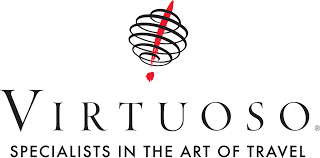
We are open 24hrs a day
-
London
-
Bangkok
-
Sydney
-
Honolulu
-
Rio de Janeiro

